… one leaf of her lemon tree showed a Hamer Focus!
Book excerpt from “Legacy of a New Medicine,” Ryke Geerd Hamer, MD, 1999.
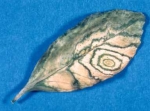
The “Gergelyfi phenomenon”: a leaf of a lemon tree with a shooting target configuration as a sign of a Hamer Focus. The brain is quasi everywhere in the plant. The HH is, therefore, simultaneously HH of the brain and the organ.
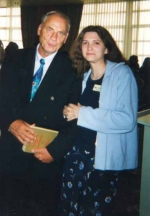
The biology student Helga Gergelyfi and the book author at the 1st International Congress for NEW MEDICINE in Biel, May ’99.
A young biology student in Vienna, Helga Gergelyfi, made an astonishing discovery on her lemon tree in her dormitory room: one leaf of her lemon tree showed a Hamer Focus!
Probably very many people have seen something like this without having thought about it. However, the biology student knew the Germanische Heilkunde® and immediately thought she saw a very familiar structure, namely a Hamer Focus, which she knew from the CT images of the brain and the organs. She broke off the sheet and showed it to her professors of botany in Vienna. They were quite perplexed. But one of them took the trouble to look through the botanical literature for such a strange and, at the same time, so clear structure. After a few days, Helga G. asked him what his research had revealed. He thought it must be a viral infestation.
Well, the professor had possibly found a grain of truth. If you look closely at the lemon tree leaf’s underside, you can see a large brown area where this Hamer Focus was found in the form of green target-like rings. A green ring means chlorophyll, which means metabolism, in this case in a larger area of decreased metabolism, which was, in fact, brown. It must be the beginning of a solution-phase with shooting disk rings, which must have been conflict-active, i.e., sharp-edged, until recently.
With the conflictolysis also comes the time of activity of the microbes. In this case, let us assume the viruses (if they exist), which would rebuild the sheet. This seems to be precisely the case here. The metabolism is reactivated again in these rings.
The conflict? The little tree had stood one night in the draft at the open window gap. After moving the plant (CL!), this shooting target configuration resulted, visible by the green rings, i.e., these were invisible or overlooked before, or colorless, now they made metabolism again, thus were green.
With conflictolysis, the previously sharp-edged, colorless rings of the Hamer Focus can become green again. So, they draw water again, make metabolism, form chlorophyll, and color the previously colorless rings green again. Here only a short conflict activity had occurred. Thus, the process of the decreased metabolism was apparently still again reversible. Thus, the shooting disc rings of the HH could turn green again during the healing phase.
If the conflict activity had lasted longer, the changes in the area of the HH would probably have been irreparable. It could have been that a hole would have resulted at the place of the HH, i.e., in the entire area of the shooting disk rings.
This would then mean that the microbes or pests are not the ones that eat the leaves (senselessly), but they would only fulfill the task that Mother Nature has assigned them for millions of years.
Suddenly, this seemingly insignificant discovery made by the young student in September 1995 is at the center, or even the starting point, of tremendous research for which we have not even had a question yet, let alone any idea of the connections.
We know from previous bacteriological research that all microbes, fungi, bacteria, and viruses (if they exist) also exist in plants. From the Germanische Heilkunde, namely from the 4th biological law of nature, we know that the microbes belong to the germ layer and work – with little overlap.
But if
Then we must be able to find these three germ layers even in the plants. germ layers are not known in botany, although there is also something like embryonic development, e.g., hazelnut, walnut, chestnut, etc…
We can now even search specifically:
Our above leaf would have to belong to it also with significant probability.
In all probability, the 5 found biological laws of nature for the special programs with man and animal are five laws of nature that have validity for all living beings.
The next question is immediately how to understand the 5 Biological Laws of Nature in plants. If everything is not deceptive, the 5th Biological Law of Nature is also – mutatis mutandis – a fifth botanical law of nature. We would have to try to understand which sensible biological special programs run off with the plants, which are degraded or built up in the respective healing phase by the microbes collaborating for millions of years, in any case in a sensible way from the Conflictolysis.
The next conclusion, according to the natural laws of Germanische Heilkunde®, if they are such, would be that the plants also have conflicts with DHS, i.e., biological conflicts, then conflict-active phases (ca-phases) and healing phases (pcl-phases).
The next logical conclusion would be that the plants each have a soul with which they react psychically, cerebrally, and organically, analogous to us. A difference to us would be that the plant does not have a head-brain and does not need one. Because all the plant cells are interlaced with each other and the mini-brains (speak cell nuclei) of the plant, which together form the organ brain. Depending on the plant’s size, such an organ brain can have a tremendous capacity that we have probably never dreamed of before; virtually a vast, large computer hard drive with tremendous power.
But it is also quite possible that the plants’ roots contain a particular brain part, something like a second brain, which could correspond to our head brain. This would make sense, especially where the plant dies entirely above ground in winter and only the root remains alive. There the brain of the plant must be than in any case – at least in the winter.
The course of the shooting target rings – the rhythm of nature
After the biology student, Helga Gergelyfi, in Vienna, had discovered the shooting target configuration at her little lemon tree at the beginning of this chapter and had suspected a Hamer Focus in it. Immediately, all our curiosity was aroused. A few days later, while walking together, my girlfriend discovered a maple leaf with a green ring. I was delighted and surprised when leaves on all kinds of trees with target rings and green rings and in all combinations fell towards us from everywhere.
It was October 25, 1995. There had been a so-called “Indian summer,” i.e., summer temperatures in late autumn for about ten days. The mechanism had been the following: There had already been cold days in early October, even short frosts. Depending on their more or less protected position, the leaves had suffered a “natural DHS” – as they must suffer every autumn so that the sap escapes from the above-ground parts and the frost does not destroy the tree. But now came this “Indian summer,” which meant that there was a partial resolution of the conflict once again. In this pcl-phase, the shooting disk rings of the leaves were edematized again. There was again metabolism and, therefore, chlorophyll. And the sign of this renewed “unscheduled” metabolism were the broad green rings, possibly even whole green dots. Partly, one can recognize the green rings at the outermost shooting disk rings.
I believe we have – as simple as it may seem in retrospect – through the “quintessence,” i.e., the 5th biological law of nature, on the track of the connections of the tremendous annual rhythm:
In autumn: the plants suffer from a “natural DHS,” speak a sensible biological special program of nature. Through sensible sympathicotonia, they “dehydrate” themselves, i.e., the tree loses water through evaporation and the failure of the supply of water from the roots. It would freeze to death in winter if it did not do this. But with little water, it can survive the frost period.
In the spring: Comes the CL (= Conflictolysis); we can also say again: The natural conflict resolution of the Sensible Biological Special Program of nature: In the vagotonic edema phase, the plants and trees draw water because, without water, the metabolism is not possible. We still have to investigate whether the plants also have an epileptoid crisis. The trees could die in this epileptoid crisis after a tough winter or at least a part of them. One would really have to make appropriate botanical observations now.
A, so I believe, enormous observation succeeded to us in the last days: We could observe that the microbes work precisely in the ring of these shooting targets, speak Hamer Focus and erode the leaf hole-shaped – or try to build up again. It would be only evident that also with the plants and trees, the microbes have no “killer function,” but only clearing function (with old-brain-controlled plant parts) and building up function (with large-brain-controlled) plant parts.
With the presumed “harmfulness of the microbes,” we would have to go back, in reality, a step: The presumed “pests do not destroy the plants,” but they are only cleared where they belong cleared and are built up again where they belong built up. The microbes – and probably even the so-called “pests” – usually only work in the context of a sensible biological special program.
This does not mean again that we could not prevent our ignorance, e.g., the clearing of a plant part by microbicides. Just as we could prevent unreasonably and ignorantly by eradicating the tubercle mycobacteria, the gastrointestinal tumors, initially useful in the context of the unique program but later completely superfluous, could be cleared appropriately. What is desired for us as a breeding or beneficial result is far from being suitable for the plant!
We must now include the plant’s soul in all biological, horticultural, and farming considerations for the first time. These plants that we exploit are not things. Similarly, animals are not things, as churches and “science” have considered them until now. We need not only animal protectors and animal experiment opponents, but also plant protectors and plant experiment opponents. This demand seems utopian and completely unrealizable at the moment. But only the idea, or the knowledge that animals and plants have a soul just like we humans, lets us become bitter animal and plant experiment opponents. But just for an entirely different reason than the past animal protectors, who were recognizably against animal experiments, but had too few arguments. They often said that one could kill the animals but should not torture them so much.
The animals give us milk, which they do not need for their young. Plants can undoubtedly give us humans – such as the grass – their leaves without having to die. The trees can give us their fruits, which they do not need for reproduction etc…
Our Judeo-Christian religion has not considered the knowledge of a soul in man, animals, and plants. The brutal handling of nature caused by the Old Testament great religions has led to the most extraordinary natural catastrophe on earth. An infinite number of animal and plant species have been wiped out solely because we have been taught to regard living beings as things that may be tortured and exploited at will. These primitive views, which have no compassion for animals and plants’ souls, have brought endless suffering to the entire earth for over 2000 years and should therefore be overcome.
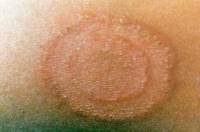
This is not a picture of a leaf but a human skin site. It shows the beginning of the pcl-phase of neurodermatitis foci.
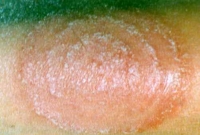
Opposite also a photo of a healing phase beginning of human skin (enlargement). Later, the rings can no longer be seen due to the bright red exanthema.
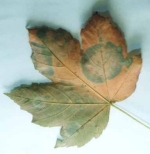
This is what it looks like when microbes process such a HH on a leaf. In this case, we do not yet know precisely what kind of microbes we see here, which appear like a whitish coating. But, interestingly, they are in action exclusively in the area of the HH. Since we do not know the types of microbes or the type of germ layer they are working on, we do not know if they are degrading, if they are still degrading, or if they are “building up.” The latter is more likely.
With all caveats, it seems that the leaf is perforated during the active phase and falls off. However, if the ca-phase has lasted only a short time or is quickly followed by a healing phase, the degradation can still be stopped, or the tissue can be rebuilt by microbes (viruses? – if they exist). Then we see the typical green rings as a sign of the returned metabolism.

Note that the green ring is on the yellow side of the leaf. The yellow upper side was turned towards the cold or not so well protected. It has suffered the conflict, at least more than the green side, on which, however, a few smaller HHe can be found, which are also processed by microbes.

On the one hand, in this maple leaf, we see small holes at sites of former active HHe. The arrow points to a spot that was – or is – about to become a hole. But we also see HHe with active target rings that were marginally still “salvageable” and got a green outer ring again. Finally, we see the large green ring as a sign of a large HH that was not so severely affected so that it could get metabolism again, as a sign of a healing repair.

Excellent to see are the shooting disk rings inside and the re-staining of these structures marginally outside as a sign of the pcl-phase. In the large, green ring structure on the left, a delicate ring structure can also be seen inside.
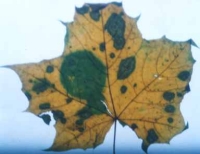
On maple leaf, all Hamer Focus stages can be seen again.
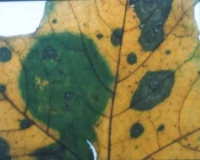
Detail enlargement of the same sheet. The shooting disk structure is visible. In each case on the outside, the HH area is apparently still salvageable, i.e., metabolically reactivatable.
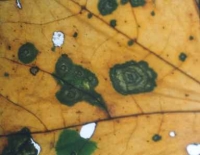
Enlargement of the previous section again: it can be seen that the leaf is perforated at the sites of HHe unless a pcl-phase quickly sets in and metabolic activity is resumed. In the upper-left corner, incipient metabolic activation. We see that “green patches” consist of a metabolically activated zone of multiple HHe, but can also have a large HH!
Strange that these target rings of plants have never been observed or at least never noticed until now, although they can be seen so well. It seemed more important to the botanists to examine the leaves microscopically. Thereby, “one did not see the forest before loud trees.”
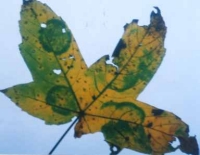
Maple leaf with particularly beautiful HH in pcl-phase. But there are also already holes where the ca-phase process was already too far advanced.
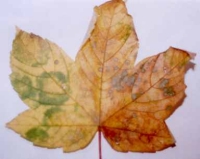
The exciting thing about this leaf is that the leaf’s left side was facing the sun or was better protected from the cold. On the left side, metabolic reactivation were possible in the form of HH. It was not enough for the right side of the leaf. The right side appears more discolored, and more brown, the HH’s shooting discs on the right have not yet caused a hole effect, but they are also no longer capable of metabolic reactivation.
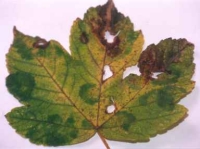
Maple leaf showing all different stages or phase sections: holes from ca-phase, “almost-holes” still in ca-phase, metabolically reactivated HHe in pcl-phase.
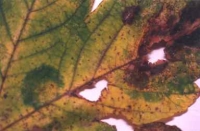
We can see that even if perforation has already occurred in the HH area. Suppose the sun provides appropriate warmth and the nights are warm. In that case, individual leaf parts can undoubtedly come into the pcl-phase again at the edge, i.e., can be reactivated metabolically (center/upper left).

The leaf’s left side was conflict-active because it was more exposed to the cold or the cold wind. Nevertheless, because Indian summer started only two days later (end of October 95), the leaf’s left side could be saved or metabolically reactivated again. On the right side of the leaf were also smaller active HHe, which now impress as deep dark spots or rings in the pcl-phase.
It seems essential that this is an “autumn process” aborted by ten warm days and nights at the end of October. Nevertheless, this “process” could be normal in areas further south.

This maple leaf could not be clearer: On a cold, windy October night, it turned yellow; that is, it suffered an active biological conflict, the particular program of which seems to be that the liquid is taken out of the leaves and twigs, frost destroys the plant. To turn yellow apparently means to have an active conflict.
After two days of cold came the summer, as mentioned above, temperatures. It caused the tree to draw water into the leaf once again and make metabolism in the ca-shooting disk rings that had been invisible until then to form chlorophyll and create these green rings. In our latitudes, the usual case would be that the ca-phase lasts continuously until spring. Then, of course, we do not find such rings colored green. Spring then, we say, draws up the water, and the leaves sprout. Have we considered that it is, in principle, the same process as the pcl appearances in our organs or brain?
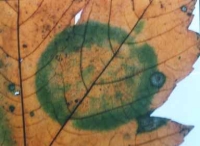
The smaller HHe of this leaf appears to have been, already shortly before the “punching,” had also recovered once again in the healing phase. Even if the healing phase was finally only a 10-day intermezzo, the tree could not know it before. It saw the biological chance to be able to become metabolically active once again.

Maple leaf with central HH in pcl-phase (green spot).
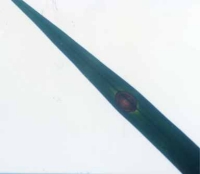
Palm leaf with an active HH. The palm tree had suffered frost with the draft wind at this point. The shooting disk rings are clearly visible. However, the rest of the leaf appears to have remained intact. It could be that the exposure to the cold lasted too long for the area to be repairable. However, the alteration was also not long enough for a hole to form in the leaf. We see, that there are not only either-or but all transitions within the laws of nature.
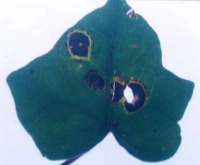
Three or four larger HH are punched in. One HH is already punched, but the HH on the left is already quasi-sequestered, i.e., marginal, immediately before the “punching.” Very good to see the target rings. The rest of the sheet has apparently not yet been significantly altered.
Our earlier idea that the microbes cause these holes was, at least in these described cases, wrong.
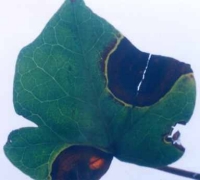
Ivy leafs with two typical Hamer Focus in which we can clearly see the shooting disc rings. Both seem to be sequestered. Below we see one already perforated, i.e., punched out. Whether such HHe can also still recover or whether the ca-phase was already too far advanced, we do not know.

Beech leaf, whose HHe was still reactivatable. Here, the microenvironment was more favorable. We will look at our plants and trees with entirely different eyes if we notice such differences soon. They are our life comrades.

Beech leaf, on which one can study well the hole formation. The HH in the picture on the right was already immediately before hole formation. But was then apparently metabolically reactivated again at the edge (arrow above) by pcl-phase. The “microenvironment” is very decisive in this process.
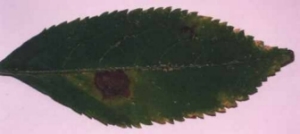
Elder leaf with a HH that beautifully shows shooting disk rings. In the center, the HH was unsalvageable, but on the outside, it was revitalized by pcl-phase.
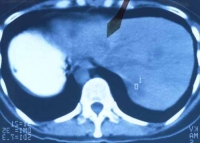
For comparison: We see an active HH in the liver, i.e., an organ HH. Such shooting target rings can be seen particularly well at the beginning of the conflict activity, i.e., after the DHS. Subsequently, new cells grow along with these shooting target rings, which are not meant to last, but only to last for the conflict-active phase. After the resolution of the conflict, they are, as is well known, tuberculously degraded.
We must see our friends, the plants, quite different in the future – as fellow creatures!
With all the cruelty that exists in nature, probably neither plants, animals, or humans could ever be as deluded as we have been in the last 2000 years. We have even been taught to look at our fellow creatures’ animals only as things – the plants even more. The crowning of stupidity brought us our so-called civilization. The crowning of the civilization can be only the “one-world” government with total control of the thinking. Germanische Heilkunde® will show the way back to our intuitive, individual abilities in this mental moonscape, to the natural-biological togetherness of all living beings, which we have lost.
However, we are not yet finished with our biological-botanical question and answer game:
Provided the five biological laws of nature apply in principle also analogously to the plants – what we must still prove – then our botanists would also get for the first time to explain why there are plant cancer necroses with plants. The plant cancer would have to be triggered then – of course, as a sensible biological special program of nature! – from the “old brain.” However, we see with the plants only a “compact-brain,” with which we can distinguish besides not at all between alto-brain-affiliation and cerebrum-affiliation.
Some of my readers may make this view into our “biological-botanical workshop” a little dizzy, but this is how one must work in the biological “criminology” of the Germanische Heilkunde® if one has five biological laws of nature.
Look, which fascinating correspondences we meet there with all diversity, which Mother Nature has thought up! With the 3rd natural law of nature, the ontogenetic system of the cancers and cancer equivalents, Mother Nature, in the conflict-active phase (ca-phase), can make both cell multiplication by mitosis and cell shrinkage, depending on from which brain parts these unique programs are controlled. The superordinate system is the so-called biological sense, which lies with the alto-brain-controlled organs evenly in the cell multiplication, with the cerebral cortex-controlled organs in the same 1. ca-phase against it; however, shrinkage is to be found in the cell. Although seemingly diametrically opposed on the organic level, both biological processes analogously make sense according to the 5th biological law of nature. And even if the organs controlled by the cerebral medulla have their biological sense at the end of the healing phase (pcl-phase) with cell proliferation, this is not a contradiction, but a variant, which Mother Nature has allowed herself. But which is always embraced by the higher lawfulness of the 5th natural law of nature.
Suppose we now want to find a connection between the plant world and the animal/human world in terms of developmental history. In that case, we first try to apply our 5 Biological Laws of Nature from the animal/human world to the plant world, as shown above. Such an approach is initially nothing more than a working hypothesis.
The plant could be, let’s assume it, for the moment, it is, of course, not entirely sure, a “one-brained being,” animal and human, on the other hand, “two-brained beings,” consisting of head-brain and organ-brain. The biological necessity of the second brain (head brain) could have resulted, e.g., from the aimed greater mobility of the individual. The big question, which already occupied Darwin, is: At which time did the plant world and the animal world split? There were probably plants some or many millions of years before there were animals – even if still very primitive ones – which could feed on these plants. On the other hand, we would have to find plant structures with us if we had ridden on the “plant train” for a while, analogous, e.g., to our rudimentary gill arches, which show us that we “swam along” with the aquatic animals for some distance.
Such common structures we did not recognize so far, or they were very general: Common so-called organic basic building blocks of carbon, oxygen, hydrogen, nitrogen and phosphate, etc., metabolism, reproduction in an unisexual or bisexual way, in short, such phenomena, which we feel like signs of life. But where did our ways diverge?
Our ways must have diverged already in the unicellular stage. Because the unicellular individual has “only” one organ brain, at least that’s what we believe today. Germanische Heilkunde®, with its laws of nature, may be able to help here. For this, we have to make a little excursion into the history of development again:
We know that many mammals in Australia underwent their own “continental evolution” at a relatively early time for mammals: Marsupials. However, the special is that approximately the same kinds developed as on the other continents (pouched rats, pouched wolves, etc.) evenly, all only with a pouch, in which the young is carried. It could be, therefore – first a working hypothesis! There has been a kind of “creation program” to which the five biological laws of nature belong. Accordingly, similar special programs could be found with the plants and the animals/humans, just such meaningful biological special programs of nature as they are proved for animal and human beings.
This whole branch of research has only become possible since medicine has become a natural science. Now we can not only carry scientific knowledge (e.g., types of organic compounds, etc.) into medicine, but for the first time, we can carry biological-medical laws of nature into biology. Natural law is natural law. Whether biological or medical does not matter from now on if both fields are naturally scientific.
We may soon have to try to understand the soul of a tree not only sentimentally but also in a very real way, that of a small flower and any plant, even if it had been called a “weed” or a “pest plant” until now. We should start with a new era and thoroughly process the last 2000 years of delusion!
In all modesty, we have made such a great discovery with the 5 Biological Laws of Nature because we have discovered 5 of the constants – perhaps there are more – which have remained constant throughout evolution. The plant and animal world has differentiated into a rich diversity.
Thus, Germanische Heilkunde® is the primordial medicine, a natural scientific system encompassing all living beings, which is at the same time very logically coherent, tremendously human, or even socio-creative. At the same time, one could almost say represents the natural religion, which applies to all living beings in the same way.
While almost all founders of religion have always taught that their God will “breakthrough” the laws of nature and thereby do miracles. The miracle in the Germanische Heilkunde® with its five biological laws of nature consists precisely in the fact that the laws of nature are just not broken through. The highest perfection consists evenly – as with the Greeks of antiquity in the classical time – in the beautiful normality, balance, not triviality! This has nothing to do with idealization, e.g., of the cruelties in nature, but in these laws of natural birth and death are included in a completely natural way.
TODAY: 72
LAST 30 DAYS: 3.010
THIS YEAR: 33.743
TOTAL: 152.858
| Cookie | Duration | Description |
|---|---|---|
| cookielawinfo-checkbox-analytics | 11 months | This cookie is set by GDPR Cookie Consent plugin. The cookie is used to store the user consent for the cookies in the category "Analytics". |
| cookielawinfo-checkbox-functional | 11 months | The cookie is set by GDPR cookie consent to record the user consent for the cookies in the category "Functional". |
| cookielawinfo-checkbox-necessary | 11 months | This cookie is set by GDPR Cookie Consent plugin. The cookies is used to store the user consent for the cookies in the category "Necessary". |
| cookielawinfo-checkbox-others | 11 months | This cookie is set by GDPR Cookie Consent plugin. The cookie is used to store the user consent for the cookies in the category "Other. |
| cookielawinfo-checkbox-performance | 11 months | This cookie is set by GDPR Cookie Consent plugin. The cookie is used to store the user consent for the cookies in the category "Performance". |
| viewed_cookie_policy | 11 months | The cookie is set by the GDPR Cookie Consent plugin and is used to store whether or not user has consented to the use of cookies. It does not store any personal data. |
You’ll be informed by email when we post new articles and novelties. In every email there is a link to modify or cancel your subscription.